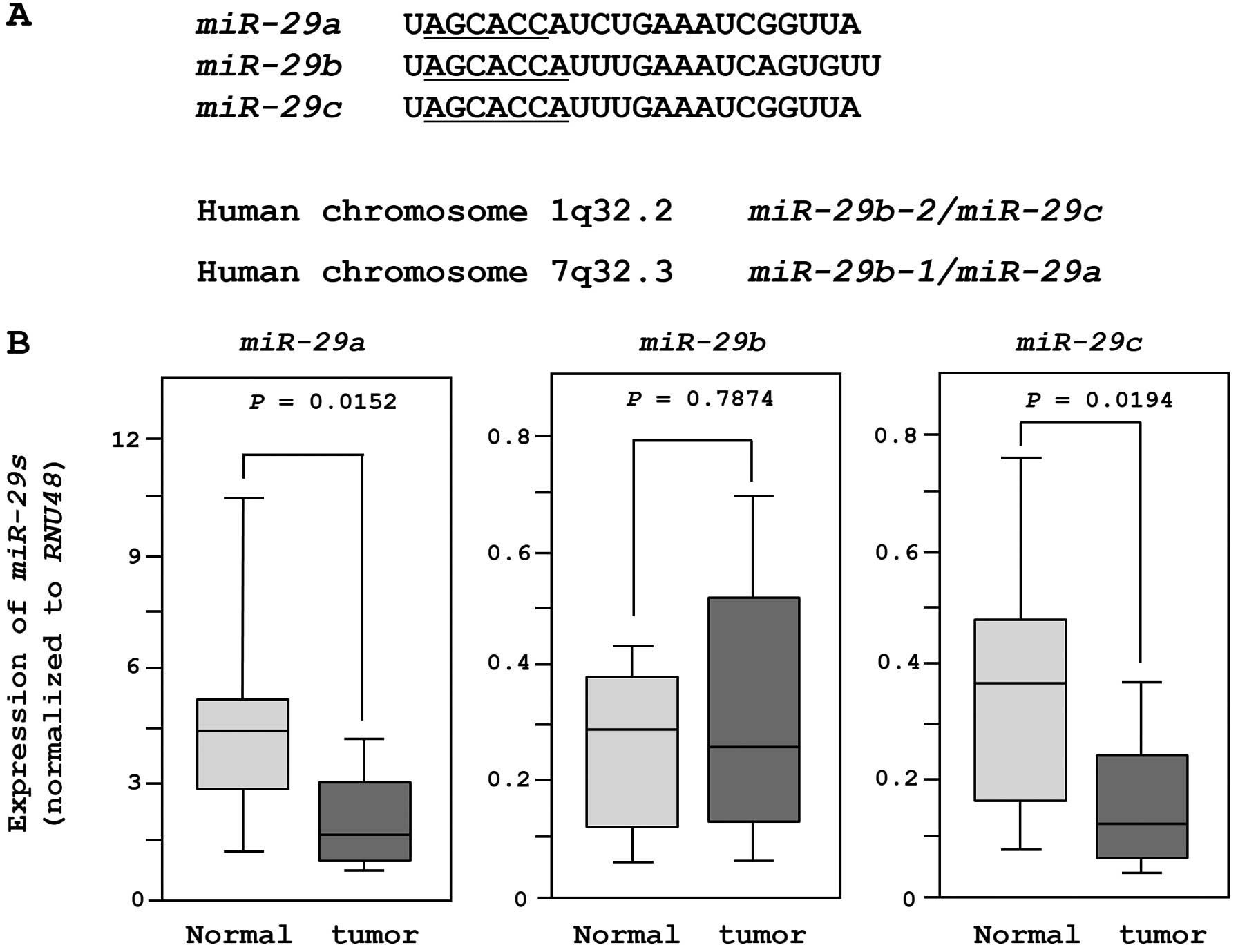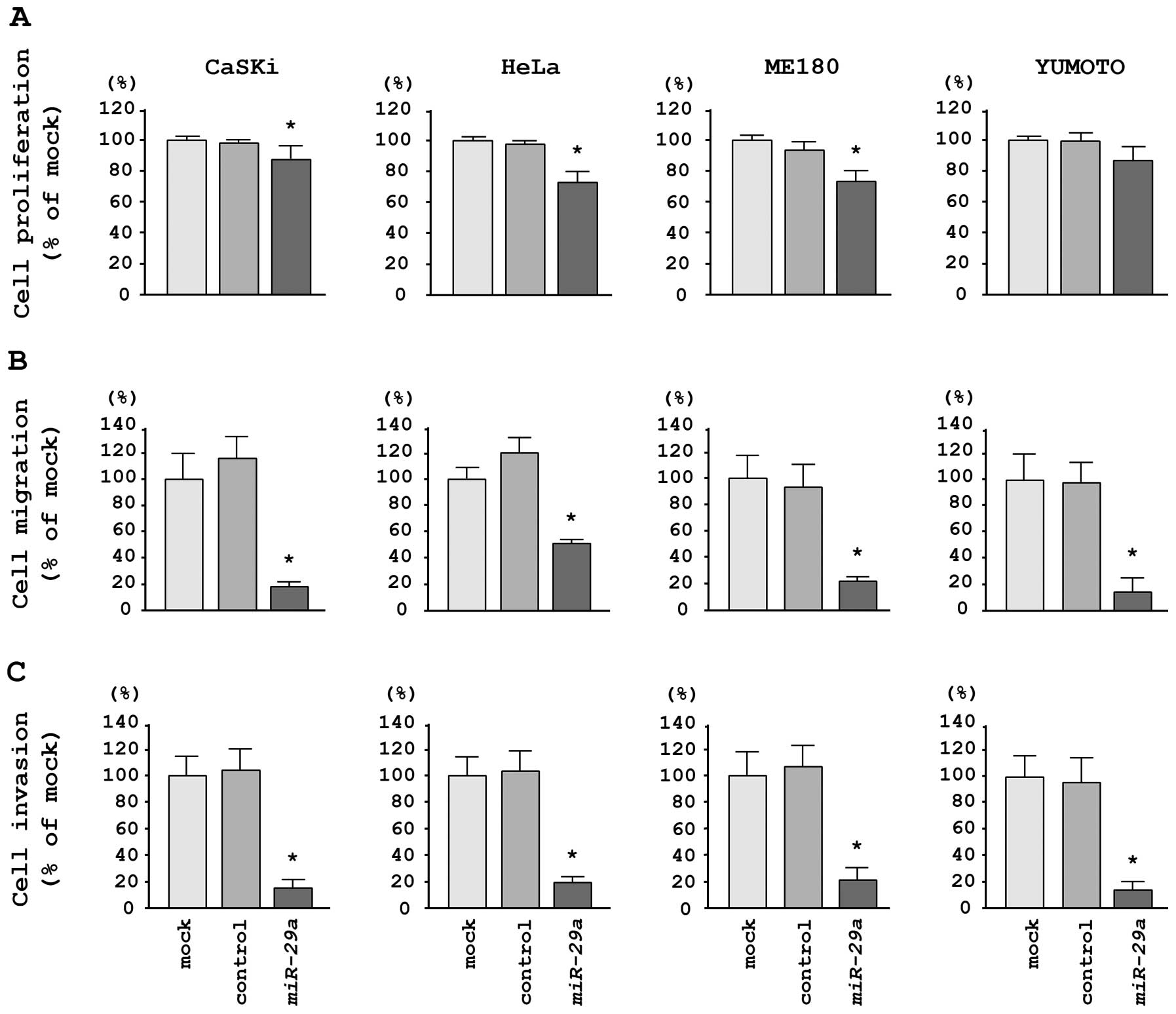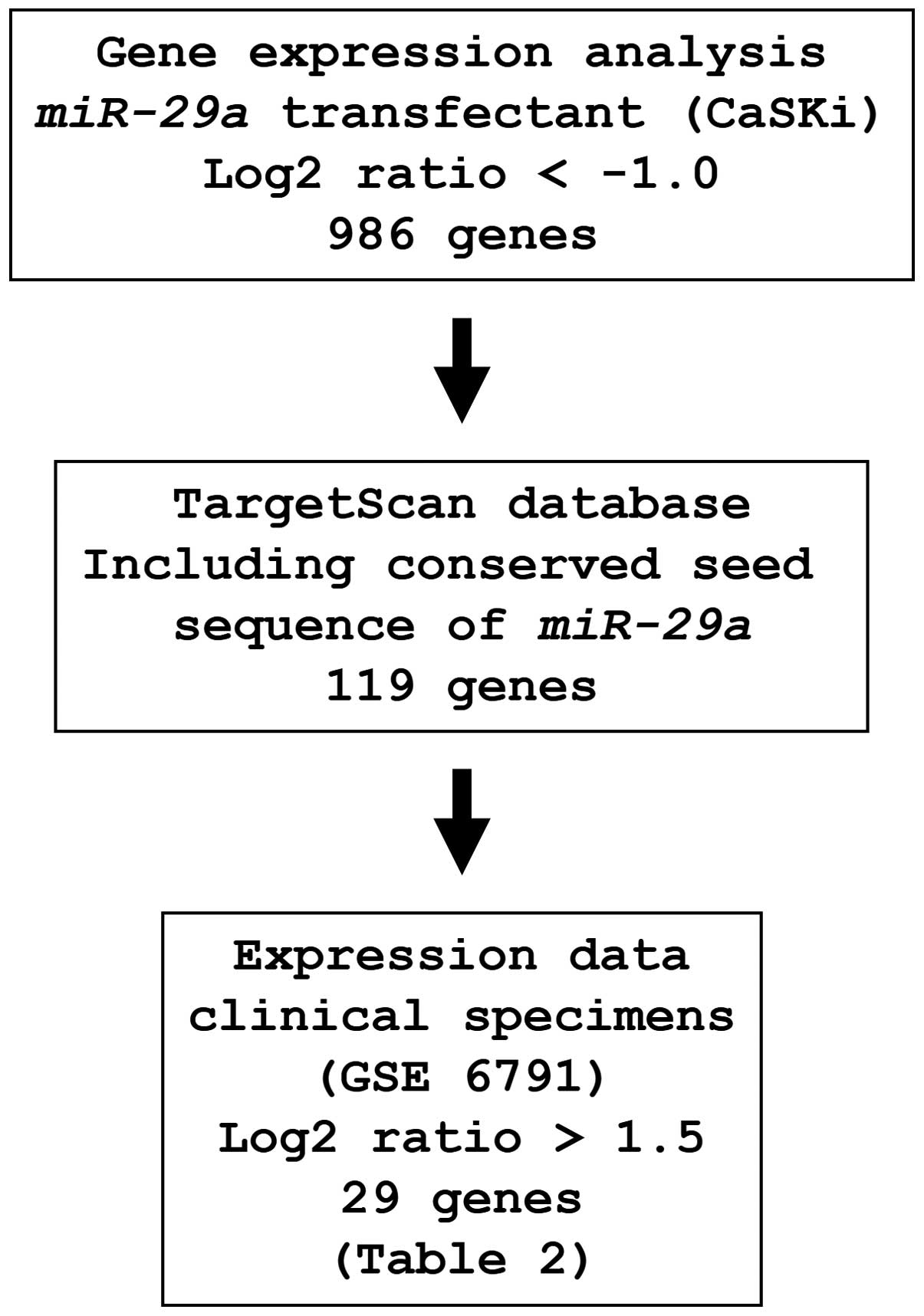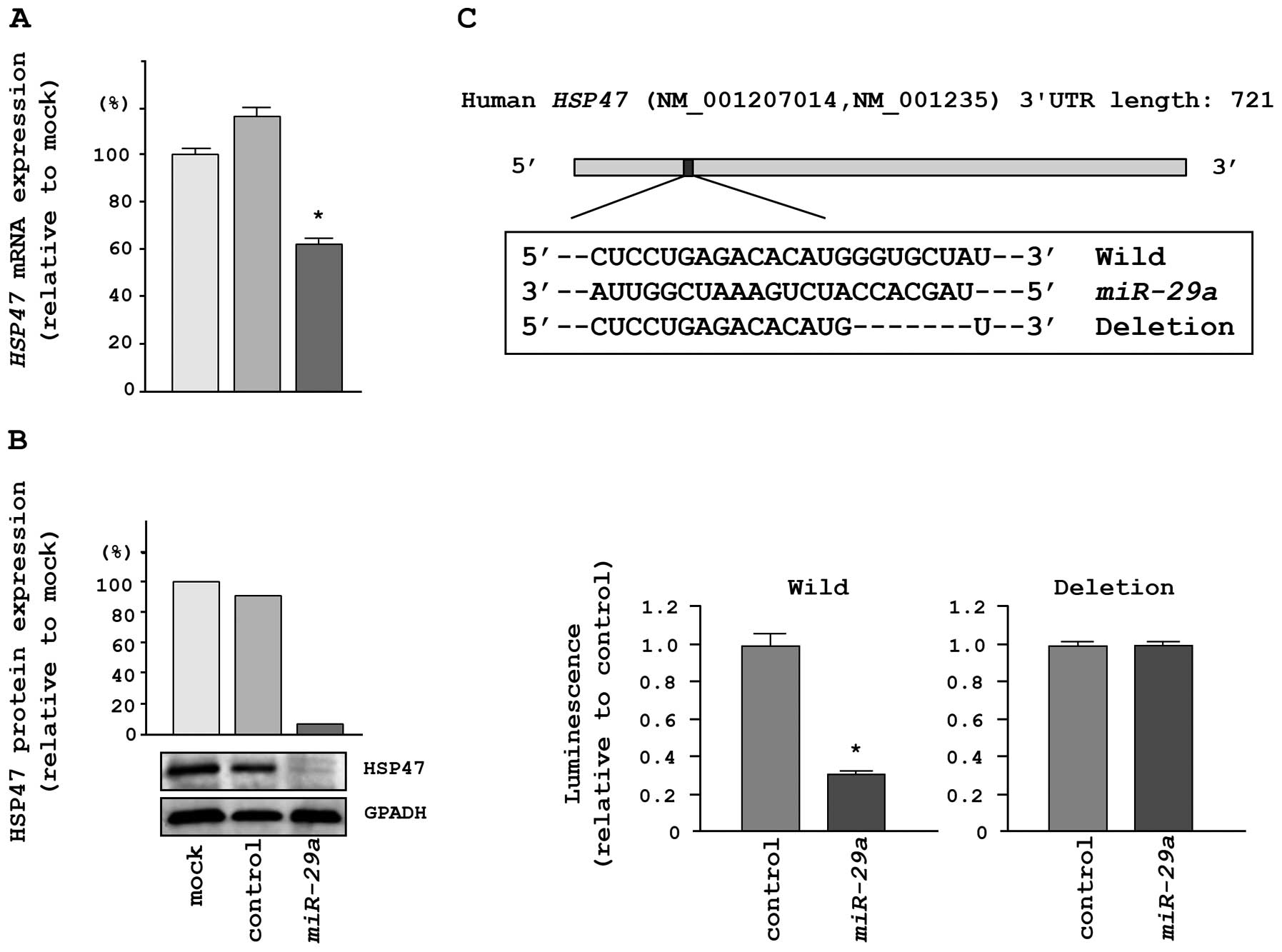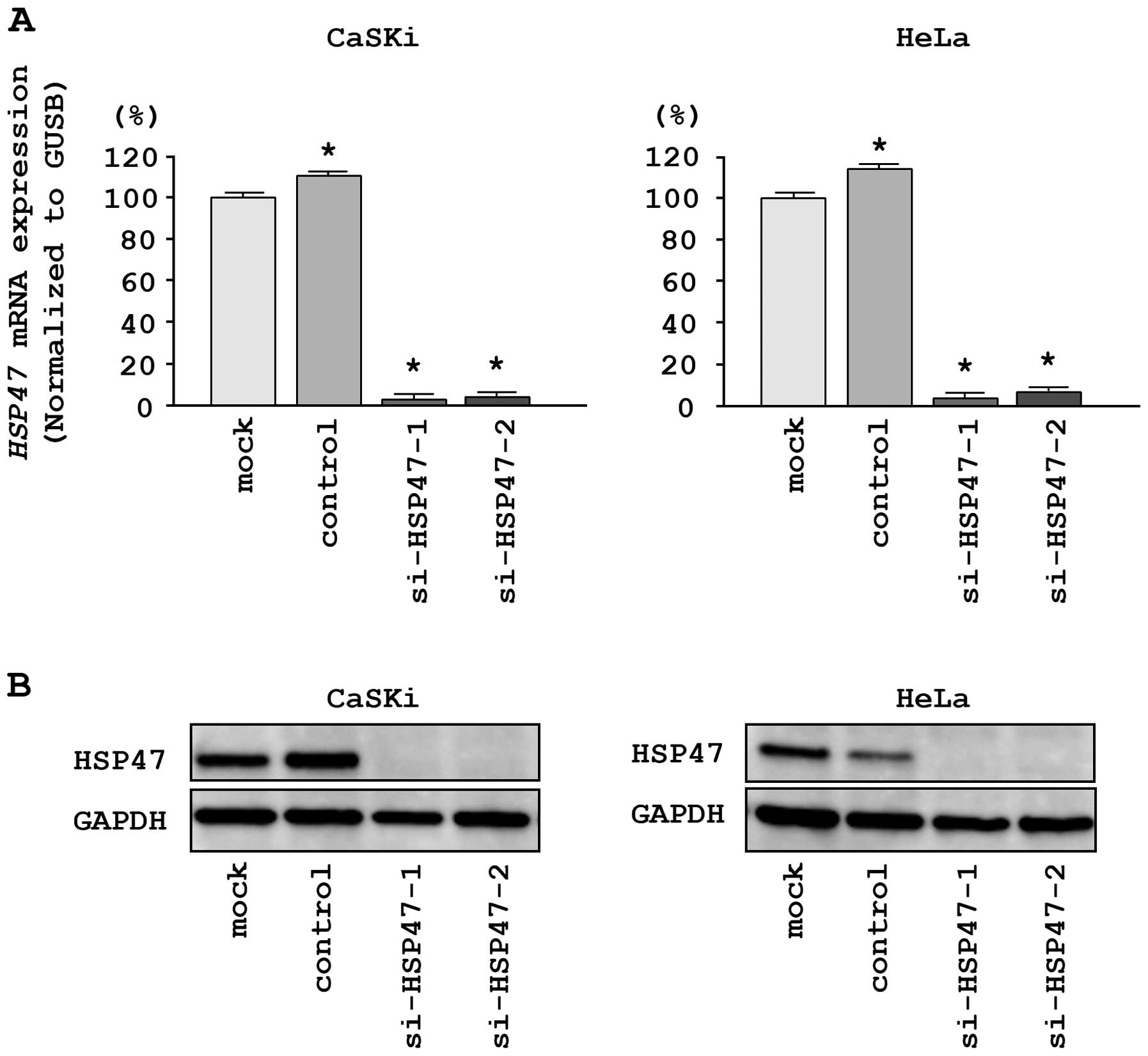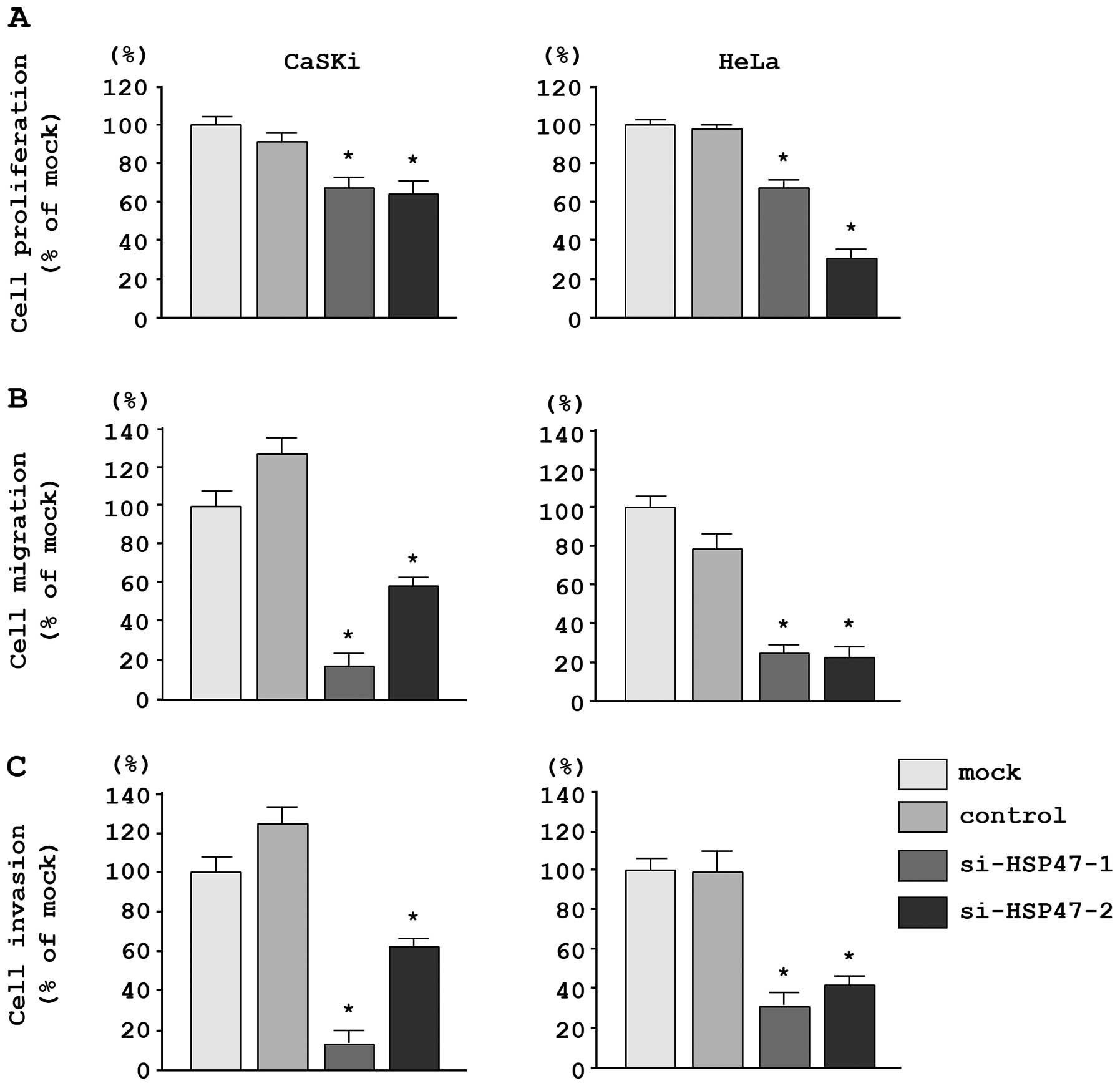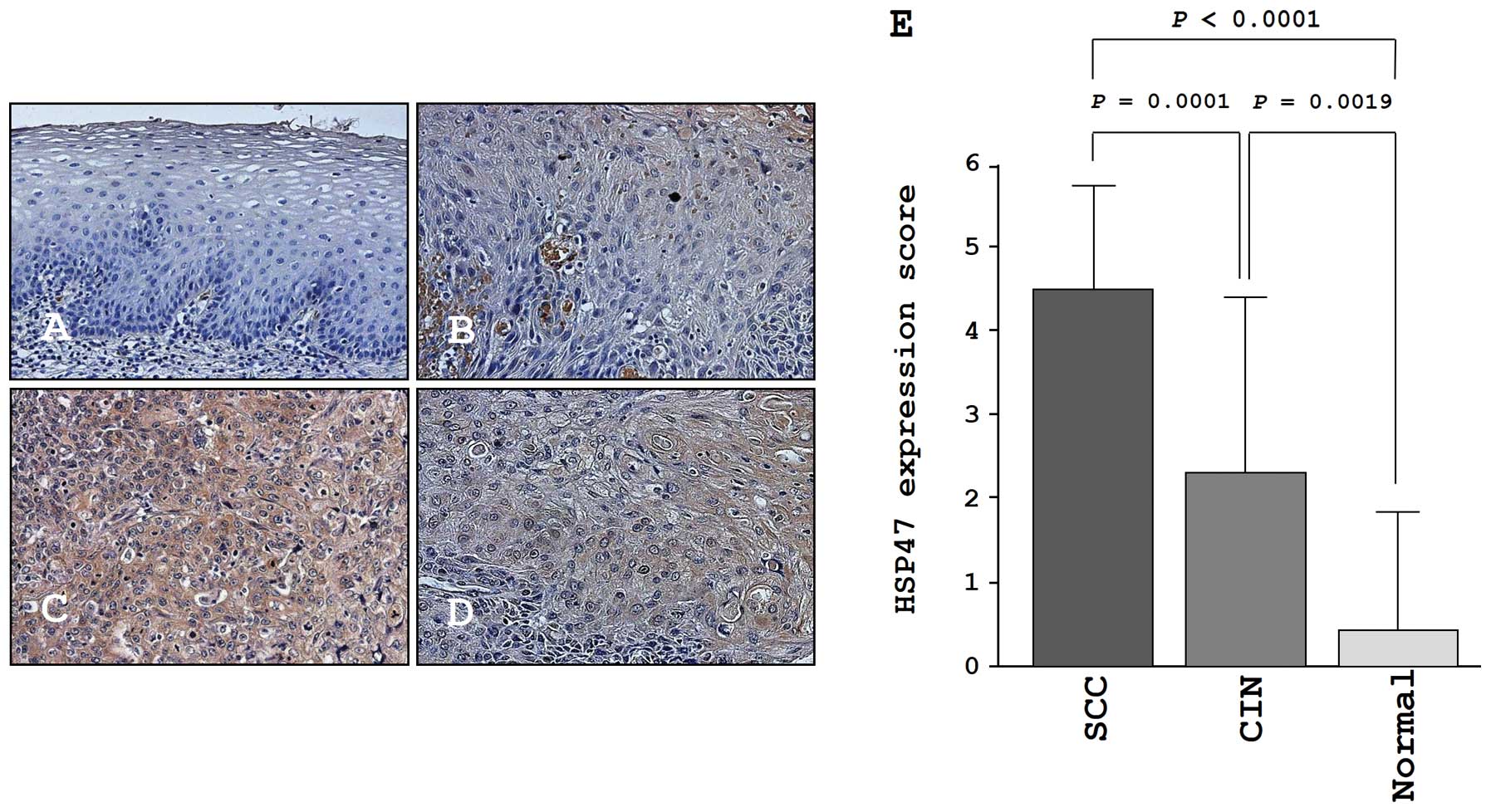Tumor-suppressive microRNA-29a inhibits cancer cell migration and invasion via targeting HSP47 in cervical squamous cell carcinoma
- Authors:
- Published online on: October 18, 2013 https://doi.org/10.3892/ijo.2013.2145
- Pages: 1855-1863
-
Copyright: © Yamamoto et al. This is an open access article distributed under the terms of Creative Commons Attribution License [CC BY_NC 3.0].
Abstract
Introduction
Cervical cancer is the second most common cause of cancer death in women worldwide and ∼500,000 new cases of cervical cancer are diagnosed each year, with 280,000 deaths (1). Cervical squamous cell carcinoma (SCC) is the most frequent type of cervical cancer and the most important risk factor for cervical-SCC is persistent human papilloma virus (HPV) infection (2–4). High-risk HPVs contain oncoproteins, i.e., E6 and E7, which contribute to the oncogenesis of cervical SCC by silencing tumor-suppressive p53 and Rb proteins and several cancer-related genes (5). Therefore, recent research on cervical SCC has focused on E6 and E7 oncoproteins. However, the molecular mechanisms of cervical SCC initiation, development, and metastasis have not yet been fully elucidated.
The discovery of non-coding RNAs in the human genome was an important conceptual breakthrough in the post-genome sequencing era (6). A growing body of evidence indicates that miRNAs are key regulators that contribute to the initiation and development of various types of cancer (7). In cancer pathways, normal regulatory mechanisms are disrupted by altered expression of tumor-suppressive or oncogenic miRNAs. Therefore, identification of differentially expressed miRNAs is an important step to understanding human oncogenesis.
Based on this, our research group has elucidated the miRNA expression signatures of various types of human cancers (8–12). Recent studies of miRNA expression signatures of hypopharyngeal SCC and maxillary SCC have indicated that expression of miRNA-29 family miRNAs (miR-29a/b/c) is significantly reduced in cancer tissues, suggesting that these miRNAs may contribute to the oncogenesis and metastasis of cervical SCC (13,14).
Expression analysis of miR-29 family miRNAs in cervical SCC clinical specimens showed that miR-29a was the most highly downregulated miRNA in the clinical specimens, thus, we focused on miR-29a in this study. The aim of the present study was to investigate the functional significance of miR-29a and to identify the molecular target genes regulated by miR-29a in cervical SCC cells. Genome-wide gene expression data and in silico database analysis showed that the heat-shock protein 47 (HSP47) gene, also known as serpin peptidase inhibitor clade H, member 1 (SERPINH1), was a promising candidate target of miR-29a.
Materials and methods
Clinical specimens
A total of 18 primary cervical SCC specimens and 11 non-cancer specimens were collected from patients who had undergone surgical treatment at Chiba University Hospital. The samples were processed and stored in liquid nitrogen until RNA extraction. Patient information is summarized in Table I. Our study was approved by the Bioethics Committee of Chiba University; prior written informed consent and approval was given by each patient. HPV status was examined by L1 consensus primers and type-specific real-time PCR primers, as described previously (15).
RNA isolation
Total RNA was isolated using TRIzol reagent (Invitrogen, Carlsbad, CA, USA) according to the manufacturer’s protocol. RNA concentrations were determined spectrophotometrically. RNA quality was confirmed using a NanoDrop 1000 Spectrophotometer (Thermo Fisher Scientific, USA).
Quantitative real-time RT-PCR
Stem-loop RT-PCR (TaqMan MicroRNA assays; P/N, 002112 for miR-29a; P/N, 000413 for miR-29b; P/N, 000587 for miR-29c; Applied Biosystems, Foster City, CA, USA) was used to quantify miRNAs according to earlier published conditions (14). To normalize the data for quantification of miR-29-family sequences, we used RNU48 (Assay ID, 001006; Applied Biosystems) as a control. The ΔΔCt method was used to calculate the fold-change.
Mature miRNA and siRNA transfections
Cervical cancer cell lines were transfected with Lipofectamine RNAiMAX transfection reagent (Invitrogen) and Opti-MEM (Invitrogen) with 10 nM mature miRNA or siRNA molecules. The following RNA species were used in this study: mature miRNA, mirVana miRNA mimic for hsa-miR-29a-3p (Product ID, MC12499; Applied Biosystems), negative control miRNA (P/N, AM17111; Applied Biosystems), small-interfering RNA (Stealth siRNAs, si-SERPINHl; P/N, HSS101423 and HSS189522; Invitrogen) and negative control siRNA (Stealth RNAi Negative Control Medium GC, P/N, 12935-300; Invitrogen).
Cell proliferation, migration and invasion assays
Cell proliferation was determined using XTT assays (Roche Applied Science, Tokyo, Japan) according to the manufacturer’s instructions. Cell migration assays were performed using modified Boyden Chambers (Transwells, Corning/Costar no. 3422, USA). Cells were transfected with 10 nM miRNA by reverse transfection and plated in 10-cm dishes at 8×l05 cells/dish. After 48 h, 1×105 cells were added to the upper chamber of each migration well and were allowed to migrate for 48 h. After gentle removal of the non-migratory cells from the filter surface of the upper chamber, the cells that migrated to the lower side were fixed and stained with Diff-Quick (Sysmex Corp., Japan). The number of cells migrating to the lower surface was determined microscopically by counting four areas of constant size per well. Cell invasion assays were carried out using modified Boyden chambers in 24-well tissue culture plates at 1×105 cells per well (BD Biosciences, USA). All experiments were performed in duplicate.
Target gene search for miR-29a
A genome-wide screen was performed to identify miR-29a-target genes using miR-29a-transfected CaSKi cells. A SurePrint G3 Human GE 8×60K Microarray (Agilent Technologies, Santa Clara, CA, USA) was used for expression profiling of miR-29a transfectants in comparison with miRNA-negative control transfectants. TargetScan release 6.2 (http://www.targetscan.org/) was used to identify predicted target genes and their miRNA binding site seed regions. Gene expression data for clinical cervical SCC specimens were obtained from the GEO database (accession no. GSE6791).
Western blot analysis
Cells were harvested and lysed 72 h after transfection. Each cell lysate (50 μg of protein) was separated using Mini-Protean TGX gels (Bio-Rad, Hercules, CA, USA), followed by subsequent transfer to PVDF membranes. Immunoblotting was performed with polyclonal anti-HSP47 antibodies (sc-5293; Santa Cruz Biotechnology, Santa Cruz, CA, USA). Anti-GAPDH antibodies (ab8245; Abeam, UK) were used as an internal control.
Plasmid construction and dual-luciferase reporter assays
Partial sequences (191 bp) of the HSP47 3′ untranslated region (3′UTR) that contain the miR-29a target site (GGTGCTA) were inserted between the XhoI and PmeI restriction sites in the 3′UTR of the hRluc gene in the psiCHECK-2 vector (Promega, Madison, WI, USA). The deletion of the miR-29a target site was cloned and constructed as deletion-vector in this study. HeLa cells were then transfected with 5 ng vector and 10 nM mature miRNA.
Immunohistochemistry
We performed immunostaining using a tissue microarray containing 60 specimens: 10 normal cervical tissues, 10 inflammation tissues, 10 cervical intraepithelial neoplasia (CIN) tissues and 30 SCC tissues (CR 602; US Biomax, Rockville, MD, USA). Detailed information on all tumor specimens can be found at http://www.biomax.us/tissue-arrays/Uterus/CR602. The tissue microarray was incubated overnight with primary mouse monoclonal antibodies against HSP47 (1:50, sc-5293, Santa Cruz Biotechnology). Next, the sample was treated with anti-mouse biotin antibodies (1:2,000, 115-065-003, Jackson ImmunoResearch Laboratories, Inc., West Grove, PA, USA) for 1 h and then treated with an ABC kit (K0377, Dako, Carpinteria, CA, USA) for 30 min. Counterstaining was performed using a DAB kit (425011, Nichirei Bioscience Inc., Tokyo, Japan). Immunostaining was evaluated according to previously described scoring methods (12).
Statistical analysis
The relationships between two variables and numerical values were analyzed using the Mann-Whitney U test and the relationships between three variables and numerical values were analyzed using the Bonferroni-adjusted Mann-Whitney U test. Expert StatView analysis software (ver. 4; SAS Institute Inc., Cary, NC, USA) was used in both analyses. In the comparison of three variables, an unadjusted statistical level of significance of P<0.05 corresponded to the Bonferroni-adjusted level of P<0.0167.
Results
Expression of miR-29-family miRNAs in clinical cervical SCC specimens
The sequences and chromosomal locations of miR-29-family miRNAs (miR-29a/b/c) in the human genome are shown in Fig. 1A. These miRNAs were clustered at two different human genomic loci, miR-29b-1 and miR-29a at 7q32.3 and miR-29b-2 and miR-29c at lq32.2.
We evaluated the expression of miR-29-family miRNAs in 18 clinical specimens and 11 non-cancer tissues. The expression levels of miR-29a and miR-29c were significantly lower in tumor tissues than in non-cancer tissues. However, there was no significant difference in the expression of miR-29b (Fig. 1B). When we compared two miRNAs (miR-29a and miR-29c) after normalization to the expression of RNU48, miR-29a was more abundantly expressed in both normal and cancer tissues.
Effects of restoring miR-29a on cell proliferation, migration, and invasion in cervical SCC cell lines
To investigate the functional effects of miR-29a, we performed gain-of-function studies using miRNA transfection in four cervical cancer cell lines. XTT assays demonstrated that cell proliferation was significantly inhibited in miR-29a transfectants in comparison with mock- or miR-control-transfected CaSKi, HeLa and ME180 cells; no inhibition was observed in Yumoto cells in this assay (Fig. 2A). We observed the following changes in proliferation, expressed as a percentage of mock-transfected cells: i) CaSKi, mock, 100.0±8.2%; miR-control, 97.9±6.6%; miR-29a, 87.6±5.9%; P=0.0032; ii) HeLa, mock, 100.0±7.5%; miR-control, 97.6±4.1%; miR-29a, 73.8±4.8%; P<0.0001; iii) ME180, mock, 100.0±4.5%; miR-control, 93.4±5.9%; miR-29a, 75.1±4.7%; P<0.0001, and iv) Yumoto, mock, 100.0±8.0%; miR-control, 99.9±10.6%; miR-29a, 85.0±9.9%; P= 0.0287 (Fig. 2A).
Migration assays demonstrated that miR-29a transfection significantly inhibited cell migration compared with mock- or miR-control-transfected cells. We observed the following changes in migration activity, expressed as a percentage of mock-transfected cells: i) CaSKi, mock, 100.0±14.0%; miR-control, 116.1+19.3%; miR-29a, 31.7±5.7%; P<0.0001; ii) HeLa, mock, 100.0±11.3%; miR-control, 124.0±14.8%; miR-29a, 55.3±10.6%; P<0.0001; iii) ME180, mock, 100.0±12.4%; miR-control, 89.8±16.8%; miR-29a, 20.3±6.4%; P<0.0001; iv) Yumoto, mock, 100.0±8.1%; miR-control, 95.4±15.8%; miR-29a, 13.0±6.3%; P<0.0001 (Fig. 2B).
Matrigel invasion assays demonstrated that cell invasion was significantly inhibited in miR-29a transfectants in comparison with mock- or miR-control-transfected cells for all cell lines tested. We observed the following changes in invasion activity, expressed as a percentage of mock-transfected cells: i) CaSKi, mock, 100.0±12.9%; miR-control, 103.4±6.3%; miR-29a, 16.6±7.5%; P<0.0001; ii) HeLa, mock, 100.0±16.5%; miR-control, 102.7±14.6%; miR-29a, 31.8+13.2%; P<0.0001; iii) ME180, mock, 100.0±22.7%; miR-control, 109.5±37.6%; miR-29a, 23.8±6.6%; P<0.0001; iv) Yumoto, mock, 100.0±11.9%; miR-control, 90.9±10.1%; miR-29a, 5.9±3.3%; P<0.0001 (Fig. 2C).
Identification of miR-29a-regulated putative target genes
To identify genes regulated by miR-29a, we used in silico and genome-wide gene expression analyses. The strategy for the selection of miR-29a-target genes is shown in Fig. 3. First, to gain further insight into which genes were affected by miR-29a, we performed genome-wide gene expression analysis using miR-29a-transfected CaSKi cells; 986 genes were identified as downregulated (log2 ratio <-1.0) by miR-29a transfection. Next, we used the TargetScan database to examine whether these genes contained miR-29a binding sequences in their 3′UTRs. Finally, the gene set was analyzed with a publicly available gene expression data set in the GEO (accession no. GSE6791), and genes upregulated (log2 ratio >1.5) in cervical SCC were chosen. A total of 29 genes were candidate miR-29a-regulated oncogenic genes in cervical SCC (Table II).
As a result of our selection strategy, we identified HSP47 as one of the most highly upregulated genes in cervical SCC tissues and one of the most significantly downregulated genes in miR-29a-transfected cells.
HSP47 was directly regulated by miR-29a
We performed qRT-PCR and western blotting in HeLa cells to investigate whether HSP47 expression was reduced by restoration of miR-29a. The mRNA and protein expression levels of HSP47 were significantly repressed in miR-29a transfectants in comparison with mock- or miR-control-transfected cells (Fig. 4A and B).
To determine whether the 3′UTR of HSP47 mRNA had an actual target site for miR-29a, we performed luciferase reporter assays using a vector encoding the 3′UTR of HSP47 mRNA. We found that the luminescence intensity was significantly reduced by transfection with miR-29a and the vector carrying the wild-type 3′UTR of HSP47, whereas transfection with a deletion vector blocked the decrease in luminescence (Fig. 4C).
Effects of silencing HSP47 on cell proliferation, migration, and invasion in cervical SCC cell lines
To investigate the functional role of HSP47, we performed loss-of-function studies using si-T/SWZ-transfected CaSKi and HeLa cells. First, we evaluated the knockdown efficiency of si-HSP47 transfection. The expression of HSP47 mRNA was repressed in two si-HSP47 transfectants as compared with mock and si-control transfectants (P<0.0001; Fig. 5A). Moreover, the expression of HSP47 protein was repressed in si-HSP471-1 and si-HSP47-2 transfectants as compared with mock and si-control transfectants (Fig. 5B). These results showed that the two siRNAs were effective for loss-of-function assays in this study.
In CaSKi and HeLa cells, XTT assays revealed significant inhibition of cell proliferation following transfection with the two different siRNAs targeting HSP47 as compared with the growth of mock- and si-control-transfected cells. The following changes in growth were observed, expressed as a percentage of control proliferation: i) CaSKi, mock, 100.0±4.7%; miR-control, 87.0±5.7%; si-HSP47-1, 66.4±5.5%; si-HSP47-2, 63.1±7.8%; ii) HeLa, mock, 100.0±8.5%; miR-control, 100.7±8.7%; si-HSP47-1, 65.9±7.4%; si-HSP47-2, 33.0±8.7% (Fig. 6A).
Moreover, migration assays demonstrated that cell migration was significantly inhibited in CaSKi and HeLa cells transfected with the two different si-HSP47 constructs. The following changes in migration were observed, expressed as a percentage of control migration: i) CaSKi, mock, 100.0±13.7%; miR-control, 129.8±9.9%; si-HSP47-1, 17.1±7.4%; si-HSP47-2, 57.7±5.3%; ii) HeLa, mock, 100.0±8.1%; miR-control, 74.3±9.8%; si-HSP47-1, 24.5±3.5%; si-HSP47-2, 22.9±4.7% (Fig. 6B).
Matrigel invasion assays demonstrated that cell invasion was significantly inhibited in CaSKi and HeLa cells transfected with the two different si-HSP47 constructs. The following changes in invasion were observed, expressed as a percentage of control invasion: i) CaSKi, mock, 100.0±24.5%; miR-control, 128.0±18.9%; si-HSP47-1, 13.3+13.8%; si-HSP47-2, 63.3±24.9%; ii) HeLa, mock, 100.0±13.1%; miR-control, 97.8±17.4%; si-HSP47-1, 32.3±9.7%; si-HSP47-2, 43.2±5.2% (Fig. 6C).
Immunohistochemistry of HSP47 in a tissue microarray
We confirmed the expression levels of HSP47 in normal cervical tissues, CIN tissues, and cancer tissues by immunohistochemical staining. Very low expression of HSP47 was observed in normal tissues (Fig. 7A). In CIN, weak expression of HSP47 was observed (Fig. 7B). In contrast, HSP47 was more strongly expressed in several tumor lesions compared to normal tissues and CIN tissues (Fig. 7C and D). The expression score of HSP47 in cervical SCC was significantly higher than that in CIN (P=0.0001) and normal tissues (P<0.0001; Fig. 7E).
Discussion
Aberrant expression of the miR-29 family miRNAs has been reported in several types of human cancers; however, the expression status varies according to the cancer type. Decreased expression of the miR-29 family has been observed in cholangiocarcinoma, nasopharyngeal cancer, non-small cell lung cancer, hepatocellular carcinoma, malignant peripheral nerve sheath tumors and mantle cell lymphoma. In contrast, upregulation of the miR-29 family was reported in breast cancer, colon cancer and acute myeloid leukemia (16). In cervical cancer, it was reported that miR-29 targets the HPV-related gene (17). In this study, our data demonstrated that miR-29a was significantly downregulated in cervical SCC clinical specimens and cell lines, regardless of the type of HPV infection. Furthermore, restoration of miR-29a in cervical cancer cells inhibited cancer cell migration and invasion, suggesting that miR-29 a functions as a tumor suppressor and may contribute to metastasis in cervical SCC.
The molecular mechanism through which miR-29a is silenced in cervical SCC is still unknown. Analysis of the promoter region of miR-29 family miRNAs in the human genome has revealed that the miR-29b-1/miR-29a promoter region contains two putative E-box sites (MYC-binding sites), a Gli-binding site and four NF-KB-binding sites (18). Moreover, increased expression of the MYC oncogene silences miR-29b-1/miR-29a expression and NF-κB signaling, which is known to be activated in inflammation-related cancers, and directly represses miR-29b-1/miR-29a promoter activity (19). Thus, it will be necessary to identify the transcription factors that contribute to the silencing of the miR-29 family in cervical SCC. Although the miR-29b-1/miR-29a and miR-29b-2/miR-29c formed cluster miRNAs are located within the same chromosomal regions, and share transcriptional units, the expression of miR-29b was not reduced in cancer tissues compared to normal tissues in this study. The reason for this is not yet clear, and further elucidation of the molecular mechanisms controlling the expression of miR-29 family miRNAs in cancer cells is necessary.
MiRNAs are unique in their ability to regulate many protein coding genes. Bioinformatic predictions have indicated that miRNAs regulate >30% of protein coding genes (20). Aberrant expression of miRNAs causes destruction of tightly regulated miRNA/protein-coding RNA networks in human cancer cells. Therefore, identification of aberrantly expressed miRNA-mediated cancer pathways and target genes is the first step in elucidating the role of miRNAs in human cancers.
According to gene expression data and in silico database analysis, a total of 29 genes were selected as candidate miR-29 a targets. Previous reports have indicated that the miR-29 family plays a dominant role in the regulation of extracellular matrix (ECM) genes. Indeed, luciferase reporter assays demonstrated that miR-29a directly targeted HSP47, a collagen-binding, heat-inducible glycoprotein. This is the first report demonstrating that HSP47 was regulated by tumor-suppressive miR-29a in cervical SCC.
HSP47, a 47-kDa heat-shock protein, was first identified in fibroblasts (21) and is located within the human chromosome 11ql3.5 region, which is frequently amplified in several types of human cancers, including cervical SCC (22). Moreover, HSP47 is localized in the endoplasmic reticulum, a cellular organelle involved in the intercellular processing and secreting of procollagens (23). Many studies have demonstrated that HSP47 is overexpressed in fibrotic diseases, including kidney fibrosis, pulmonary fibrosis, cardiac fibrosis, and liver cirrhosis (24). Fibrosis is a common disease of organ dysfunction and is closely associated with ECM proteins, such as collagens, actins and fibronectins (25). Interestingly, members of the miR-29 family have been shown to be involved in regulating ECM proteins and multiple studies have indicated that aberrant expression of miR-29 family members contributes substantially to the development of disease (26). Thus, down-regulation of the miR-29 family and dysregulation of HSP47 and ECM components are key events contributing to the pathogenesis of diseases, suggesting that these molecules are potential therapeutic targets.
Overexpression of HSP47 has been reported in pancreatic cancer, gastric cancer, and head and neck squamous cell carcinoma (27–29). Our present data also support previous reports, suggesting that silencing of miR-29a caused overexpression of HSP47 and was an important event in the pathogenesis of cervical SCC, contributing to cancer cell migration and invasion in particular. The epithelial-to-mesenchymal transition (EMT) is a fundamental biological process whereby epithelial cells lose their polarity and undergo a transition to a mesenchymal phenotype (30). Initiation of the EMT requires external signals, such as epidermal growth factor (EGF), fibroblast growth factor (FGF), hepatocyte growth factor (HGF), and transforming growth factor-β (TGF-β) (31). The TGF-β pathway is a prominent inducer of the EMT and expression of the miR-29 family has been shown to have an inverse relationship with the TGF-β pathway. Restoration of miR-29 family members directly suppresses TGF-β1 and TGF-β2 and disrupts the expression of ECM proteins (32). Furthermore, ECM molecules, including collagen type I, promote the EMT through integrin and discoidin domain receptor-1 signaling (33,34). Thus, the understanding of molecular pathways and targets regulated by the tumor-suppressive miR-29 family may provide new insights into the EMT process in cervical SCC and facilitate the development of more effective strategies for future therapeutic interventions for this disease.
In conclusion, downregulation of miR-29 a is a frequent event in cervical SCC. Moreover, tumor-suppressive miR-29a directly regulates HSP47, a molecular chaperone involved in the maturation of collagen molecules. Restoration of miR-29a or silencing of HSP47 inhibited cancer cell migration and invasion, suggesting that the miR-29a-HSP47 pathway contributes to the metastasis of cervical SCC. Identification of molecular targets regulated by tumor-suppressive miRNAs will provide insights into the potential mechanisms of cervical SCC oncogenesis and metastasis, facilitating the development of novel therapeutic strategies for the treatment of this disease.
Acknowledgements
This study was supported by the KAKENHI (C), 24592590.
References
|
Jemal A, Bray F, Center MM, Ferlay J, Ward E and Forman D: Global cancer statistics. CA Cancer J Clin. 61:69–90. 2011. View Article : Google Scholar | |
|
Walboomers JM, Jacobs MV, Manos MM, et al: Human papillomavirus is a necessary cause of invasive cervical cancer worldwide. J Pathol. 189:12–19. 1999. View Article : Google Scholar : PubMed/NCBI | |
|
Munoz N, Bosch FX, de Sanjose S, et al: Epidemiologic classification of human papillomavirus types associated with cervical cancer. N Engl J Med. 348:518–527. 2003. View Article : Google Scholar : PubMed/NCBI | |
|
Clifford GM, Smith JS, Plummer M, Munoz N and Franceschi S: Human papillomavirus types in invasive cervical cancer worldwide: a meta-analysis. Br J Cancer. 88:63–73. 2003. View Article : Google Scholar : PubMed/NCBI | |
|
Munger K and Howley PM: Human papillomavirus immortalization and transformation functions. Virus Res. 89:213–228. 2002. View Article : Google Scholar : PubMed/NCBI | |
|
Filipowicz W, Bhattacharyya SN and Sonenberg N: Mechanisms of post-transcriptional regulation by microRNAs: are the answers in sight? Nat Rev Genet. 9:102–114. 2008. View Article : Google Scholar : PubMed/NCBI | |
|
Nelson KM and Weiss GJ: MicroRNAs and cancer: past, present, and potential future. Mol Cancer Ther. 7:3655–3660. 2008. View Article : Google Scholar : PubMed/NCBI | |
|
Kano M, Seki N, Kikkawa N, et al: miR-145, miR-133a and miR-133b: Tumor-suppressive miRNAs target FSCN1 in esophageal squamous cell carcinoma. Int J Cancer. 127:2804–2814. 2010. View Article : Google Scholar : PubMed/NCBI | |
|
Moriya Y, Nohata N, Kinoshita T, et al: Tumor suppressive microRNA-133a regulates novel molecular networks in lung squamous cell carcinoma. J Hum Genet. 57:38–45. 2012. View Article : Google Scholar : PubMed/NCBI | |
|
Hidaka H, Seki N, Yoshino H, et al: Tumor suppressive microRNA-1285 regulates novel molecular targets: aberrant expression and functional significance in renal cell carcinoma. Oncotarget. 3:44–57. 2012. | |
|
Ichimi T, Enokida H, Okuno Y, et al: Identification of novel microRNA targets based on microRNA signatures in bladder cancer. Int J Cancer. 125:345–352. 2009. View Article : Google Scholar : PubMed/NCBI | |
|
Kojima S, Chiyomaru T, Kawakami K, et al: Tumour suppressors miR-1 and miR-133a target the oncogenic function of purine nucleoside phosphorylase (PNP) in prostate cancer. Br J Cancer. 106:405–413. 2012. View Article : Google Scholar : PubMed/NCBI | |
|
Kikkawa N, Hanazawa T, Fujimura L, et al: miR-489 is a tumour-suppressive miRNA target PTPN11 in hypopharyngeal squamous cell carcinoma (HSCC). Br J Cancer. 103:877–884. 2010. View Article : Google Scholar : PubMed/NCBI | |
|
Nohata N, Hanazawa T, Kikkawa N, et al: Tumour suppressive microRNA-874 regulates novel cancer networks in maxillary sinus squamous cell carcinoma. Br J Cancer. 105:833–841. 2011. View Article : Google Scholar : PubMed/NCBI | |
|
Yamamoto N, Kinoshita T, Nohata N, et al: Tumor suppressive microRNA-218 inhibits cancer cell migration and invasion by targeting focal adhesion pathways in cervical squamous cell carcinoma. Int J Oncol. 42:1523–1532. 2013.PubMed/NCBI | |
|
Wang Y, Zhang X, Li H, Yu J and Ren X: The role of miRNA-29 family in cancer. Eur J Cell Biol. 92:123–128. 2013. View Article : Google Scholar : PubMed/NCBI | |
|
Li Y, Wang F, Xu J, et al: Progressive miRNA expression profiles in cervical carcinogenesis and identification of HPV-related target genes for miR-29. J Pathol. 224:484–495. 2011. View Article : Google Scholar : PubMed/NCBI | |
|
Mott JL, Kurita S, Cazanave SC, Bronk SF, Werneburg NW and Fernandez-Zapico ME: Transcriptional suppression of miR-29b-l/miR-29a promoter by c-Myc, hedgehog, and NF-kappaB. J Cell Biochem. 110:1155–1164. 2010. View Article : Google Scholar : PubMed/NCBI | |
|
Wang H, Garzon R, Sun H, et al: NF-kappaB-YYl-miR-29 regulatory circuitry in skeletal myogenesis and rhabdomyosarcoma. Cancer Cell. 14:369–381. 2008. View Article : Google Scholar : PubMed/NCBI | |
|
Bartel DP: MicroRNAs: genomics, biogenesis, mechanism, and function. Cell. 116:281–297. 2004. View Article : Google Scholar : PubMed/NCBI | |
|
Nagata K, Saga S and Yamada KM: Characterization of a novel transformation-sensitive heat-shock protein (HSP47) that binds to collagen. Biochem Biophys Res Commun. 153:428–434. 1988. View Article : Google Scholar : PubMed/NCBI | |
|
Nagai N, Tetuya Y, Hosokawa N and Nagata K: The human genome has only one functional hsp47 gene (CBP2) and a pseudogene (pshsp47). Gene. 227:241–248. 1999. View Article : Google Scholar : PubMed/NCBI | |
|
Ishida Y and Nagata K: Hsp47 as a collagen-specific molecular chaperone. Methods Enzymol. 499:167–182. 2011. View Article : Google Scholar : PubMed/NCBI | |
|
Sauk JJ, Nikitakis N and Siavash H: Hsp47 a novel collagen binding serpin chaperone, autoantigen and therapeutic target. Front Biosci. 10:107–118. 2005. View Article : Google Scholar : PubMed/NCBI | |
|
Hubmacher D and Apte SS: The biology of the extracellular matrix: novel insights. Curr Opin Rheumatol. 25:65–70. 2013. View Article : Google Scholar : PubMed/NCBI | |
|
Kriegel AJ, Liu Y, Fang Y, Ding X and Liang M: The miR-29 family: genomics, cell biology, and relevance to renal and cardiovascular injury. Physiol Genomics. 44:237–244. 2012. View Article : Google Scholar : PubMed/NCBI | |
|
Maitra A, Iacobuzio-Donahue C, Rahman A, et al: Immunohistochemical validation of a novel epithelial and a novel stromal marker of pancreatic ductal adenocarcinoma identified by global expression microarrays: sea urchin fascin homolog and heat shock protein 47. Am J Clin Pathol. 118:52–59. 2002. View Article : Google Scholar | |
|
Hirai K, Kikuchi S, Kurita A, et al: Immunohistochemical distribution of heat shock protein 47 (HSP47) in scirrhous carcinoma of the stomach. Anticancer Res. 26:71–78. 2006.PubMed/NCBI | |
|
Lee SS, Tseng LH, Li YC, Tsai CH and Chang YC: Heat shock protein 47 expression in oral squamous cell carcinomas and upregulated by arecoline in human oral epithelial cells. J Oral Pathol Med. 40:390–396. 2011. View Article : Google Scholar : PubMed/NCBI | |
|
Jing Y, Han Z, Zhang S, Liu Y and Wei L: Epithelial-mesenchymal transition in tumor microenvironment. Cell Biosci. 1:292011. View Article : Google Scholar : PubMed/NCBI | |
|
De Craene B and Berx G: Regulatory networks defining EMT during cancer initiation and progression. Nat Rev Cancer. 13:97–110. 2013.PubMed/NCBI | |
|
Gebeshuber CA, Zatloukal K and Martinez J: miR-29a suppresses tristetraprolin, which is a regulator of epithelial polarity and metastasis. EMBO Rep. 10:400–405. 2009. View Article : Google Scholar : PubMed/NCBI | |
|
Shintani Y, Fukumoto Y, Chaika N, Svoboda R, Wheelock MJ and Johnson KR: Collagen I-mediated up-regulation of N-cadherin requires cooperative signals from integrins and discoidin domain receptor 1. J Cell Biol. 180:1277–1289. 2008. View Article : Google Scholar : PubMed/NCBI | |
|
Shintani Y, Maeda M, Chaika N, Johnson KR and Wheelock MJ: Collagen I promotes epithelial-to-mesenchymal transition in lung cancer cells via transforming growth factor-beta signaling. Am J Respir Cell Mol Biol. 38:95–104. 2008. View Article : Google Scholar : PubMed/NCBI |



